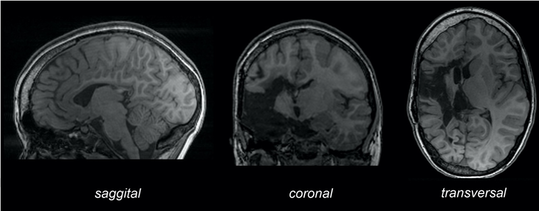
To identify potential criteria to demarcate consciousness, the project will primarily focus on two research areas: brain organisms and machine consciousness, but our borderline blog is open to all cases of borderline consciousness (e.g., comatose patients, plants, invertebrates, etc.).
Area 1. Consciousness in new brain organisms
We will examine potential consciousness in brain organisms that are entirely disconnected from any sensory or motor regions, from the rest of the body, or from the environment, including ex-cranio brains, cerebral organoids or isolated hemispheres after hemispherotomy. Special attention will be paid to hemispherotomy. This is a neurosurgical intervention to treat severe seizure disorders and involves disconnecting a brain hemisphere from the other hemisphere and the subcortical structures. Image 1. below shows a brain scan after the intervention. Some researchers have recently agued that the lesional hemisphere that is in complete neuronal isolation can be considered an "island of awareness", based on studies on electrocorticography (Hawasli et al., 2017), local functional connectivity observations, and blood oxygenation levels in the isolated hemisphere (Hertz-Pannier et al., 2002). These findings raise methodological questions about how such "islands of awareness" might be detected. Should we invent new tools and new criteria than those traditionally used to identify cerebral awareness? They also raise ontological and phenomenological questions about the very nature of consciousness. Should we, for example, accept forms of 'disconnected' consciousness or non-subjective forms of consciousness? These issues also pose urgent ethical questions that particularly concern the clinical manipulation of these organisms.
Image 1. Exemplary MR-images from a patient after hemispherotomy (male, 21 years old). Saggital, coronal and transversal describe the anatomical planes of view. The isolated hemisphere is the right one (left side of the image by convention). Please note the surprising amount of intact brain tissue beside the obvious lesions in this patient.
Area 2. Consciousness in machines
ChatGPT and other new chatbots have become so good at imitating human interaction that they have led some people to wonder whether they are even conscious. In the second part of our project, we aim to find ways to tackle this question. To do so, we will consider whether our currently best theories of human and non-human animal consciousness (e.g., global workspace theory, higher-order theories, etc.) can provide the resources to develop an answer. For instance, do some AI systems have the right structural properties (e.g., human-like global workspace architecture) to plausibly count as conscious? We will also conduct theoretical comparisons between AI/machines and human cognition to explore potential degrees of consciousness in AI systems. In this context, we will investigate to what extent potentially promising demarcation criteria for consciousness in borderline human cases (e.g., for comatose patients) may also be used to decide whether some AI systems qualifies as conscious as well. We will approach these questions in an interdisciplinary way by combining the philosophy and neuroscience of consciousness with the latest findings on the most recent AI research (e.g., on ChatGPT and AI theory-of-mind).
Area 1. Consciousness in new brain organisms
We will examine potential consciousness in brain organisms that are entirely disconnected from any sensory or motor regions, from the rest of the body, or from the environment, including ex-cranio brains, cerebral organoids or isolated hemispheres after hemispherotomy. Special attention will be paid to hemispherotomy. This is a neurosurgical intervention to treat severe seizure disorders and involves disconnecting a brain hemisphere from the other hemisphere and the subcortical structures. Image 1. below shows a brain scan after the intervention. Some researchers have recently agued that the lesional hemisphere that is in complete neuronal isolation can be considered an "island of awareness", based on studies on electrocorticography (Hawasli et al., 2017), local functional connectivity observations, and blood oxygenation levels in the isolated hemisphere (Hertz-Pannier et al., 2002). These findings raise methodological questions about how such "islands of awareness" might be detected. Should we invent new tools and new criteria than those traditionally used to identify cerebral awareness? They also raise ontological and phenomenological questions about the very nature of consciousness. Should we, for example, accept forms of 'disconnected' consciousness or non-subjective forms of consciousness? These issues also pose urgent ethical questions that particularly concern the clinical manipulation of these organisms.
Image 1. Exemplary MR-images from a patient after hemispherotomy (male, 21 years old). Saggital, coronal and transversal describe the anatomical planes of view. The isolated hemisphere is the right one (left side of the image by convention). Please note the surprising amount of intact brain tissue beside the obvious lesions in this patient.
Area 2. Consciousness in machines
ChatGPT and other new chatbots have become so good at imitating human interaction that they have led some people to wonder whether they are even conscious. In the second part of our project, we aim to find ways to tackle this question. To do so, we will consider whether our currently best theories of human and non-human animal consciousness (e.g., global workspace theory, higher-order theories, etc.) can provide the resources to develop an answer. For instance, do some AI systems have the right structural properties (e.g., human-like global workspace architecture) to plausibly count as conscious? We will also conduct theoretical comparisons between AI/machines and human cognition to explore potential degrees of consciousness in AI systems. In this context, we will investigate to what extent potentially promising demarcation criteria for consciousness in borderline human cases (e.g., for comatose patients) may also be used to decide whether some AI systems qualifies as conscious as well. We will approach these questions in an interdisciplinary way by combining the philosophy and neuroscience of consciousness with the latest findings on the most recent AI research (e.g., on ChatGPT and AI theory-of-mind).